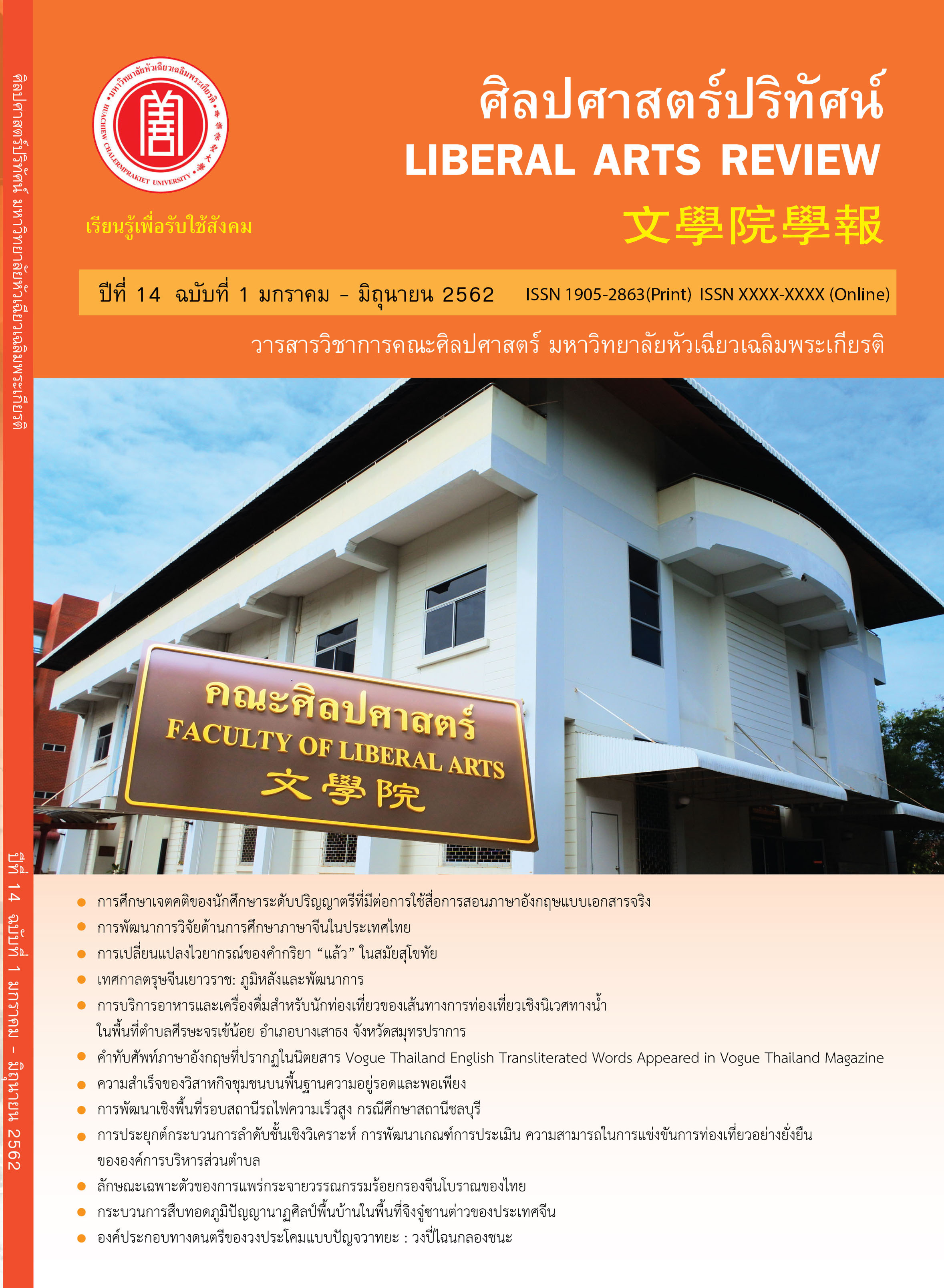Musical Element of Panchavadya Music Ensemble : Pee chanai Klong chana ensemble
Keywords:
Musical Element of Panchavadya, Music EnsembleAbstract
Research about musical element of Panchavadya Music Ensemble : Pee chanai Klong chana ensemble. This is a part of the research Panchavadya Music Ensemble in Thailand. It’s a qualitative research , aim to study and analyze the style of the ensemble , the appearance of the music instruments , sound system , style of songs , rhythm , style to play. Gathered the information by an interview form and an observation form. Use Popular Duty Theory of Redcliff Brown to analyze role of Pee chanai Klong chana ensemble and also use idea line of Sa – ngad Pukhaothong to analyze the musical element of Pee chanai Klong chana.
After studying found that Pee chanai Klong chana ensemble is a provisional ensemble , play to tell the time and participate in the Royal , the apostle and the very important person cremation ceremony. The ensemble consists of Pee chanai Klong Pueng Mang and Klong chana. The number and type of Klong is up to the estate of the death. The appearance of Pee is as loudspeaker. Both side of Klong made from leather and tie with scream leather to speed the sound. Loud system of Pee chanai is exactly the same level of Tangnai loud level. The songs that always play is Payasoke – loi – lom. Klong chana hits along along with Klong Pueng Mang. When the player of Pueng Mang challenge , Klong chana will be hit along together. If it’s Royal Cremation Ceremony , Klong Pueng Mang will be hit at the end. At the end , if horns start , Pee cheva and Klong chana will start playing. Style to play this ensemble is the same in every ceremony.
References
กรมการศาสนา. (2553).คำให้การขุนหลวงวัดประดู่ทรงธรรม เอกสารจากหอหลวง. กรุงเทพมหานคร: สำนักงานเลขาธิการสภาการศึกษา.
เจนจิรา เบญจพงศ์(ผู้รวบรวม). (2555). ดนตรีอุษาคเนย์. กรุงเทพมหานคร: เรือนแก้วการพิมพ์.
ไชยวุธ โกศล. (2545). ดนตรีประโคมศพ: กรณีศึกษาเพลงบัวลอย. (วิทยานิพนธ์ปริญญามหาบัณฑิต) มหาวิทยาลัยมหิดล, นครปฐม.
ธนิต อยู่โพธิ์. (2523). เครื่องดนตรีไทยเครื่องดนตรีไทยพร้อมด้วยตำนานการผสมวงมโหรีปี่พาทย์ และเครื่องสาย(พิมพ์ครั้งที่ 3). กรุงเทพมหานคร: กรมการศาสนา.
บุญตา เขียนทองกุล. (2548). ดนตรีในพระราชพิธี. กรุงเทพมหานคร: ดอกเบี้ย.
ผู้จัดการออนไลน์. (2560). เคลื่อนริ้วขบวนพระบรมอิสริยยศที่ 1 ออกจากประตูเทวาภิรมย์ สมเด็จพระเจ้าอยู่หัว ทรงร่วมเสด็จฯ. ค้นคืนจากhttps://mgronline.com/onlinesection/detail/ 9600000108694
พระราชพงศวดารกรุงศรีอยุธยา ฉบับพันจันทนุมาศ (เจิม) และพระราชพงศวดารกรุงศรีอยุธยาฉบับหลวงประเสริฐ(พิมพ์ครั้งที่ 4). (2545). กรุงเทพมหานคร: คุรุสภาลาดพร้าว.
ยศ สันตสมบัติ. (2556). มนุษย์กับวัฒนธรรม(พิมพ์ครั้งที่ 4). กรุงเทพมหานคร: สามลดา.
รวี สิริอิสสระนันท์(บรรณาธิการ). (2559). พระราชพงศวดารกรุงศรีอยุธยา ฉบับพันจันทนุมาศ (เจิม) และพระราชพงศวดารกรุงศรีอยุธยาฉบับหลวงประเสริฐ, คำให้การกรุงเก่า, คำให้การขุนหลวงหาวัด. กรุงเทพมหานคร: โสภณการพิมพ์.
สงัด ภูเขาทอง. (2532). การดนตรีไทยและทางเข้าสู่ดนตรีไทย. กรุงเทพมหานคร: Dr.Sax
สมเด็จพระเจ้าบรมวงศ์เธอ กรมพระยาดำรงราชานุภาพ. (2473). ตำนานเครื่องมโหรีปี่พาทย์.พระนคร: อักษรนิติ์.
อนันต์ ศรีระอุดม. เจ้าหน้าที่พระราชพิธีสำนักพระราชวัง. (15 พฤศจิกายน 2559). สัมภาษณ์.
Mahitha, V. (2013). The role of music in the temples of northern kerala. Retrived from https://bit.ly/2JHg0DL
Downloads
Published
How to Cite
Issue
Section
License
บทความที่ได้รับการตีพิมพ์เป็นลิขสิทธิ์ของวารสารศิลปศาสตร์วิชาการและวิจัย
ข้อความที่ปรากฏในบทความแต่ละเรื่องในวารสารวิชาการเล่มนี้เป็นความคิดเห็นส่วนตัวของผู้เขียนแต่ละท่านไม่เกี่ยวข้องกับมหาวิทยาลัยหัวเฉียวเฉลิมพระเกียรติ และคณาจารย์ท่านอื่นๆ ในมหาวิทยาลัยฯ แต่อย่างใด ความรับผิดชอบองค์ประกอบทั้งหมดของบทความแต่ละเรื่องเป็นของผู้เขียนแต่ละท่าน หากมีความผิดพลาดใดๆ ผู้เขียนแต่ละท่านจะรับผิดชอบบทความของตนเองแต่ผู้เดียว




